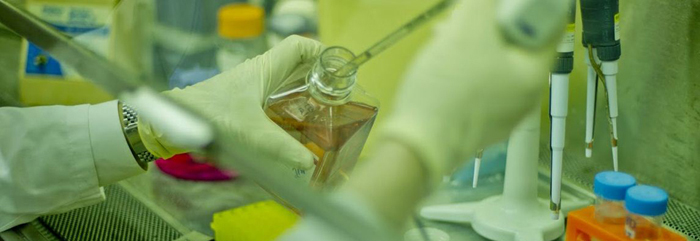Key Accomplishments
amfAR, The Foundation for AIDS Research, is one of the world’s leading nonprofit organizations dedicated to the support of AIDS research, HIV prevention, treatment education, and advocacy. Since 1985, amfAR has raised nearly $950 million in support of its programs and has awarded more than 3,800 grants to research teams worldwide.

NEW TREATMENTS
- Funded early studies that were critical to the development of protease inhibitors, the powerful drugs that revolutionized the treatment of HIV/AIDS and contributed to a drastic reduction in AIDS-related deaths.
- Supported research that led to the initial identification and characterization of the compound eventually approved for clinical use as Fuzeon, the first in a new class of AIDS drugs called fusion inhibitors.
- Supported studies leading to identification of the critical role of the cell protein CCR5 in HIV infection. This pivotal finding was instrumental to the development of maraviroc, an anti-HIV drug that works by blocking the CCR5 co-receptor.
PREVENTION
- Pioneered research that ultimately led to the use of antiretroviral drugs to block mother-to-infant HIV transmission. As a result, mother-to-child transmission has been all but eliminated in the industrialized world.
- Provided early support for the development of microbicides—topical creams or gels that could be discreetly applied prior to sexual intercourse as a means of preventing the sexual transmission of HIV.
- Supported studies of syringe exchange programs (SEPs) in several cities around the U.S. showing that these programs reduce HIV transmission by 50 percent or more among participating injection drug users, without increasing illegal drug use.
- Provided support for the only national survey of SEPs, whose results are published annually in the CDC’s Morbidity and Mortality Weekly Report.
- Supported an evaluation of the effectiveness of using physician prescription to provide sterile syringes to injection drug users in a community-clinic setting via a pilot study.
VACCINES
- Supported the expansion of the range of vaccine concepts, including the first study to demonstrate the potential of a DNA vaccine to slow disease progression.
- Funded research leading to the first three-dimensional images of HIV both before and while it makes initial contact with susceptible cells, information that could be used to design new vaccine and drug treatment candidates
CLINICAL STUDIES
- Established a Community-Based Clinical Trials (CBCT) Network, which showed that involving the HIV-infected community in clinical research expanded research capacity and expedited the drug approval process.
- The CBCT Network facilitated the approval of aerosolized pentamidine as a preventive for Pneumocystis carinii pneumonia; rifabutin as a treatment for Mycobacterium avium complex; and the FDA-approved treatment for AZT-induced anemia using erythropoietin.
- Undertook a first-of-its-kind randomized controlled study comparing two treatments for hepatitis C (HCV) in HIV-infected individuals, which revealed that interferon alfa-2b plus ribavirin is more effective at eliminating HCV than interferon alone.
INTERNATIONAL
- Supported a landmark study in Kenya that showed that HIV transmission can occur from females to males (in addition to vice versa), and that the presence of other sexually transmitted infections in either partner can increase the risk of HIV transmission. Awarded in 1987, this was amfAR’s first grant addressing the international epidemic.
- Undertook an HIV prevention education program in Nepal, initiated in 1993, that provided technical assistance to community-level prevention activities conducted by 17 nongovernmental agencies.
- Created TREAT Asia in 2001. This network of clinics, hospitals, and research institutions is working to ensure the safe and effective delivery of HIV/AIDS treatments throughout Asia and the Pacific.
- Launched the international GMT Initiative (formerly the MSM Initiative) in 2007, which provides grants to grassroots groups in support of innovative HIV/AIDS services for gay men, other men who have sex with men, and transgender individuals (collectively, GMT) in resource-limited countries. Grants will also be used to improve communication and increase collaboration among organizations, and to support advocacy efforts.
DIAGNOSTICS
- Supported the development of a technique to detect viral RNA that is now used in viral load testing and has helped improve diagnosis and monitoring of HIV infection.
EPIDEMIOLOGY
- Formed a 17,000-person observational database following the course of HIV disease before and after treatment in the United States.
- Established Asia’s first HIV/AIDS observational database to monitor disease course and treatment outcomes, generating information that will help improve treatment standards for patients across the continent.
PUBLIC POLICY
- Played a key role in securing passage of federal legislation, including: the Hope Act of 1988, the first comprehensive federal AIDS legislation; the Ryan White CARE Act of 1990, which provides emergency relief to hard-hit states and local communities and remains a primary source of federal funding for HIV/AIDS services and care; the Americans With Disabilities Act of 1990, which protects people with HIV and AIDS; and the NIH Revitalization Act of 1993, which strengthened NIH’s Office of AIDS Research.
- Helped convince Congress to establish the first AIDS drug assistance program to help low-income Americans cover the high cost of HIV/AIDS medications.
- Supported studies of the ethical issues surrounding the balance between protection of the public health and respect for individual privacy and freedom, civil liberty issues raised by case reporting and contact tracing, and the use and misuse of HIV antibody testing.
- Pioneered studies that have generated important information on the nature and extent of discrimination against people with AIDS; early medical intervention for HIV-positive people; HIV and substance abuse prevention and treatment; long-term care for people with HIV/AIDS; and the costs of financing care for people with HIV/AIDS.
INFORMATION AND EDUCATION
- Through its HIV/AIDS Treatment Directory and subsequently the amfAR Global Link and Treatment Insider, amfAR was among the first to compile and disseminate detailed information on HIV/AIDS treatments and clinical trials for people with HIV/AIDS and healthcare professionals.
